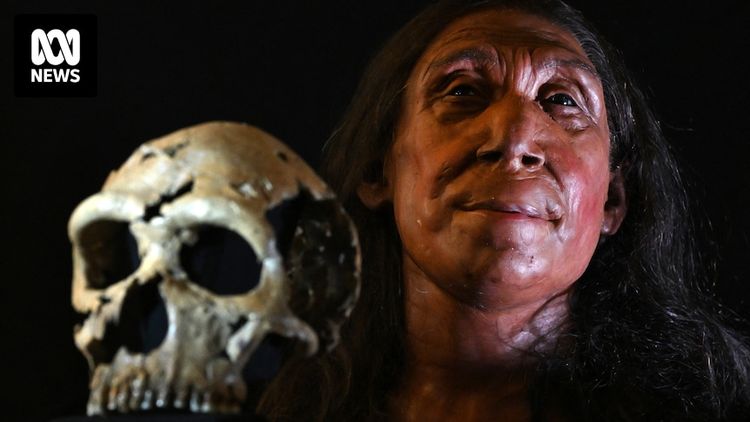UK archaeologists reveal reconstructed face of 75,000yo Neanderthal woman

A group of archaeologists from the United Kingdom recently unveiled the recreated appearance of a Neanderthal lady who lived some 75,000 years ago.
The skull of a Neanderthal woman, estimated to be in her forties, was discovered in 2018 in a cave in Iraqi Kurdistan, which is now known as Shanidar Z. This recent finding has prompted specialists to investigate the enigma of how this woman, who was buried in a sleeping position under a large, upright stone marker, lived and died.
In 1960, a well-known American archaeologist named Ralph Solecki discovered several Neanderthal bones in a profound excavation. Her lower skeleton was among the remains found.
After stumbling upon a group of corpses, one of which was surrounded by clusters of old pollen, he boldly asserted that this was proof of funeral customs that involved laying the deceased on a bed of blossoms, sparking much disagreement.
Due to issues within the political sphere, it took nearly 50 years for a group of researchers from Cambridge and Liverpool John Moores universities to receive permission to return to the location situated in the Zagros Mountains located in the northern region of Iraq.
The final Neanderthal species experienced an enigmatic extinction nearly 40,000 years back. This cessation occurred within a short period after the arrival of humans, just a few thousand years.
The Shanidar Z skull is believed to be the most well-preserved discovery of a Neanderthal in this century. However, it was flattened to a thickness of two centimeters, potentially due to a rockfall shortly after her passing.
The team in charge of excavating Shanidar Cave, led by Professor Graeme Barker from the McDonald Institute for Archaeological Research at Cambridge, recently made an astonishing discovery. According to reports, they found an unexpected abundance of Neanderthal remains. Professor Barker admitted that they were taken aback by this unusual find.
"We aimed to establish the age of the burials in order to use the location to add to the ongoing discussion surrounding the cause of the Neanderthals' extinction, but then we stumbled upon these fragments," he explained.
The fifth body found in the group that was buried behind a rock in the center of the cave is known as Shanidar Z. It is estimated that these bodies were buried over several hundred years.
Experts in ancient human history propose that the rock served as a marker that aided nomadic Neanderthals in recognizing the location where they had to lay their deceased.
Recently, Professor Chris Hunt from John Moores University in Liverpool conducted research indicating that the pollen thought to support Mr Solecki's disputed "flower burial" hypothesis could have been brought into the cave by bees that dug into the floor.
Professor Hunt mentioned that although previous assumptions were made about the lack of empathy in Neanderthals, there is still proof that contradicts this belief. This evidence includes the discovery of the remains of a partially paralyzed Neanderthal, which were found by Mr Solecki.
According to him, Mr Solecki initiated a significant reassessment while in a cave with a person named 'Shanidar 1'. The person had a withered arm, arthritis and was unable to hear well, but was still taken care of. This indicates the presence of compassion.
He stated that the arrangement of the corpses within the group being in identical locations, poses, and orientations suggested "custom" and the "transference of teachings from one age group to another."
'Challenge Yourself: 3D Puzzle Game'
He said that it seems to be a deliberate conduct that wouldn't be linked with the conventional Neanderthal tales of harsh, cruel and brief existences.
Emma Pomeroy, the scientist who specializes in the study of ancient humans, revealed her experience of discovering Shanidar Z. She expressed her emotions by describing the discovery of the skull and upper body as thrilling yet unnerving.
Before taking it out in small, wrapped blocks, the sediment around the skeleton needed to be reinforced with a sticky substance called a consolidate.
According to Dr Emma Pomeroy, discovering the skull was both thrilling and frightening at the same time.
Lucia Lopez-Polin, the primary caretaker, assembled over 200 pieces of skull to start reconstructing the face as part of the recently released Netflix documentary, Secrets of the Neanderthals.
According to Ms Pomeroy, performing the task was similar to assembling a complex 3D puzzle with a lot at stake. This was particularly difficult due to the delicate nature of the fragments, which had the same consistency as a biscuit that had been dipped in tea.
According to Ms. Pomeroy, the skulls of Neanderthals had distinct physical features that set them apart from the skulls of humans. These features included prominent brow ridges and a lack of a defined chin.
However, she stated that the reconstructed face implies that the contrast between the Neanderthals and humans may not have been as extreme during their existence. This emphasizes the fact that the two species interbred extensively, which is evident even today as almost everyone possesses Neanderthal DNA.















































